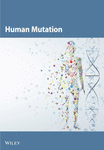Identification of a novel mutation in the coding region of the grey-lethal gene OSTM1 in human malignant infantile osteopetrosis†
Communicated by Arnold Munnich
Abstract
Autosomal recessive malignant infantile osteopetrosis (ARO) is characterized by severe osteosclerosis, pathologic fractures, hepatosplenomegaly, and pancytopenia. The pathophysiological basis is inadequate bone resorption due to osteoclast dysfunction. In the majority of cases, mutations in either of two human genes cause this fatal disorder: TCIRG1, encoding a subunit of the osteoclast H+-ATPase, and the voltage-gated chloride channel gene CLCN7. We excluded both genes in a small inbred family with malignant infantile osteopetrosis and undertook linkage analysis of several candidate loci that are involved in murine osteopetrosis. A region spanning more than 20 cM between the markers D6S1717 and D6S1608 on chromosome 6q21 was found to be homozygous in the affected child. This locus is syntenic to the genomic region harboring the gene for the osteopetrotic mutant mouse grey-lethal (gl). Recently, mutations in a novel gene of unknown function were described in the grey-lethal mouse and in one human patient. Mutation screening of the grey-lethal gene (OSTM1), revealed a homozygous 2-bp deletion in exon 2 (c.415_416delAG) in the affected child. No mutations could be found in six independent ARO patients who had tested negative for mutations in TCIRG1 and CLCN7. In summary, we describe the identification of a novel mutation in the coding sequence of the human grey-lethal gene, which is the second OSTM1 mutation found in human ARO, confirming the involvement of this gene in the pathogenesis of this severe bone disease. Hum Mutat 23:471–476, 2004. © 2004 Wiley-Liss, Inc.




